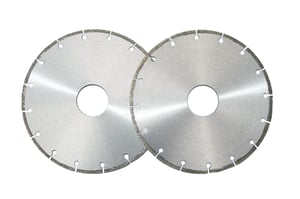Grinding Composites: Using Electroplated and Resin Bond Diamond Wheels
In the dynamic world of materials science, composites have revolutionized numerous industries such as aerospace, automotive, and medical, thanks to their high strength-to-weight ratio and flexibility. But with these advantages comes a unique set of challenges, particularly when it comes to grinding these materials. Diamond wheels, specifically with electroplated and resin bonds, have emerged as the best solution to these challenges, opening up new horizons for composite processing.
 Abrasive:
Abrasive:
Diamond - An unparalleled superabrasive for composites due to its extraordinary hardness and excellent thermal conductivity, diamond is the top choice for grinding composites. Diamond wheels can efficiently cut through the hardness of reinforced composites, while their superior thermal conductivity helps dissipate the heat produced during grinding, reducing the risk of damage to the composite material.
Bond:
Electroplated and Resin Bonds: The bond type in diamond wheels plays a pivotal role. Among the different bond types, electroplated and resin bonds are the go-to choices for composites.
Electroplated wheels, also known as diamond-coated wheels, offer unmatched grit retention and a single layer of diamond exposed at the surface. This enables aggressive grinding and excellent form-holding, crucial for the precision grinding of composites.
On the other hand, resin bond diamond grinding wheels are renowned for their cool and fast cutting capability. They are typically used in composite grinding to prevent any potential heat damage. Resin bonds also offer a good balance between wheel durability and material removal rate.
Maximizing the Performance of Your Diamond Wheel
Grit Size: In composite grinding, selecting the appropriate grit size is essential for the precision and surface finish of the final product. A coarser grit size is usually selected for rough grinding, while a finer grit is used for finish grinding.
Coolant: One of the key considerations for composite grinding is the use of coolant. Coolant is important in composite grinding to minimize heat damage. In this regard, water-based coolants, known for their high heat absorption capacity, are preferred.
RPMs: The correct RPM (Revolutions Per Minute) is crucial when using electroplated and resin bond diamond wheels, especially when grinding or cutting composites. Maintaining the right RPM ensures that the abrasive action of the diamond particles is optimized, leading to precise cuts and efficient material removal. Furthermore, using the appropriate RPM reduces the risk of excessive heat generation, which can compromise both the integrity of the composite material and the lifespan of the wheel itself. In short, adhering to the recommended RPM range safeguards the quality of the finished product and prolongs the usability of the wheel.
Despite their higher initial cost, the longevity, precision, and reduced downtime offered by diamond wheels make them a sound investment for composite grinding.
![]()
Electroplated and resin bond diamond wheels have revolutionized the grinding of composites, turning a complex process into a precision and efficiency-driven operation. To learn more about how our diamond wheels can optimize your composite grinding process, please contact us. Explore our case studies and testimonials to see how we've facilitated progress across various industries.
Recent Posts
Subscribe to email updates
Subscribe to our blog to get the latest updates from the experts on Grinding Wheels! You can easily unsubscribe at any time




